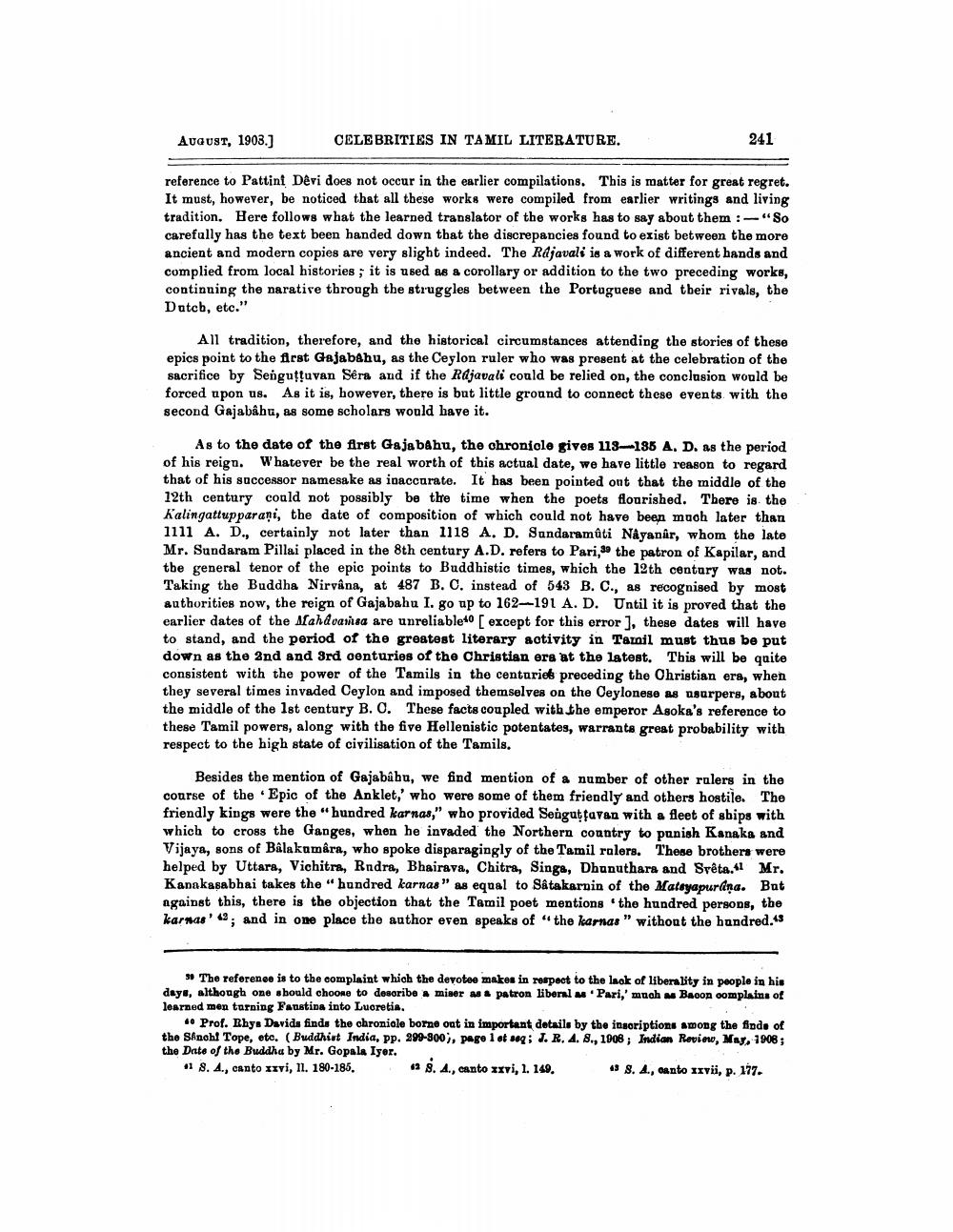________________
AUGUST, 1903.)
CELEBRITIES IN TAMIL LITERATURE.
241
reference to Pattini Devi does not occur in the earlier compilations. This is matter for great regret. It must, however, be noticed that all these works were compiled from earlier writings and living tradition. Here follows what the learned translator of the works has to say about them :-"So carefully has the text been handed down that the discrepancies found to exist between the more ancient and modern copies are very slight indeed. The Rdjavali is a work of different bands and complied from local histories; it is used as a corollary or addition to the two preceding works, continuing the narative through the struggles between the Portuguese and their rivals, the Dutcb, etc."
All tradition, therefore, and the historical circumstances attending the stories of these epics point to the first Gajabahu, as the Ceylon ruler who was present at the celebration of the sacrifice by Sengutuvan Sêra and if the Rdjavali could be relied on, the conclusion would be forced upon us. As it is, however, there is but little ground to connect these events with the second Gajababu, as some scholars would have it.
As to the date of the first Gajabahu, the chronicle gives 113_185 A.D. as the period of his reign. Whatever be the real worth of this actual date, we have little reason to regard that of his successor namesake as inaccurate. It has been pointed ont that the middle of the 12th century could not possibly be the time when the poets flourished. There is the Kalingattupparani, the date of composition of which could not have been much later than 1111 A. D., certainly not later than 1118 A. D. Sandaramậti Nayanar, whom the late Mr. Sundaram Pillai placed in the 8th century A.D. refers to Pari, the patron of Kapilar, and the general tenor of the epic points to Buddhistic times, which the 12th century was not. Taking the Buddha Nirvana, at 487 B. C. instead of 543 B. C., as recognised by most authorities now, the reign of Gajabahu I. go up to 162-191 A. D. Until it is proved that the earlier dates of the Afahdoarsa are unreliableto [except for this error], these dates will have to stand, and the period of the greatest literary activity in Tamil must thus be put down as the 2nd and 3rd centuries of the Christian era at the latest. This will be quite consistent with the power of the Tamils in the centuriet preceding the Christian era, when they several times invaded Ceylon and imposed themselves on the Ceylonese as usurpers, about the middle of the 1st century B. O. These facts coupled with the emperor Asoka's reference to these Tamil powers, along with the five Hellenistic potentates, warrants great probability with respect to the high state of civilisation of the Tamils.
Besides the mention of Gajabûhu, we find mention of a number of other rulers in the course of the Epic of the Anklet,' who were some of them friendly and others hostile. The friendly kings were the "hundred karnas," who provided Senguttavan with a fleet of ships with which to cross the Ganges, when he invaded the Northern country to punish Kanaka and Vijaya, sons of Balakumara, who spoke disparagingly of the Tamil rolers. These brothers were helped by Uttara, Vichitra, Rndra, Bhairava, Chitra, Singa, Dhunuthara and Srêta. Mr. Kanakasabhai takes the hundred karnas" as equal to Satakarnin of the Matsyapurana. Bat against this, there is the objection that the Tamil poet mentions the hundred persons, the karnas', and in one place the author even speaks of "the karnas" without the hundred."
9 The reforence is to the complaint which the devotee makes in respect to the lack of liberality in people in his days, although one should choose to describe a miser m. patron liberal as Pari,' much w Bacon complains of learned men turning Faustina into Lucretia.
4. Prof. Rhys Davida finds the chronicle borne out in important details by the inscriptions among the finds of the Sinoht Tope, etc. (Buddhist India, pp. 299-300), page 1 ots: J. R. 4. 8., 1008 ; Indian Review, May, 1908; the Date of the Buddha by Mr. Gopala Iyor. +1 8. 4., canto xxvi, 11. 180-185.
8. A., canto xxvi, 1. 149. 45 8. 4., oanto xvii, p. 117.




